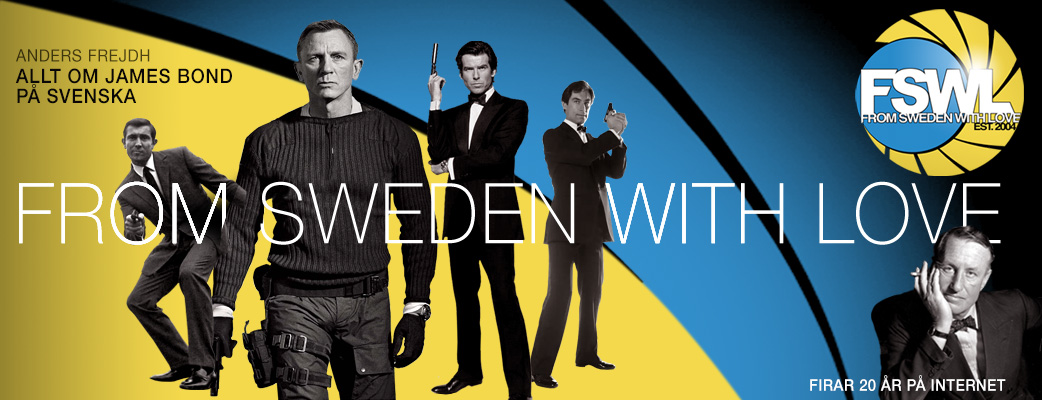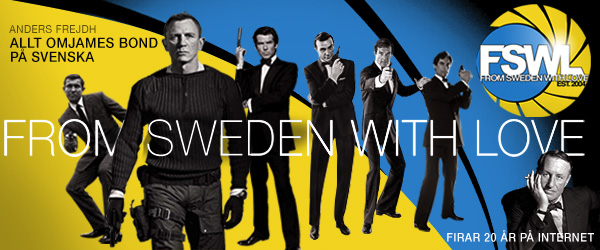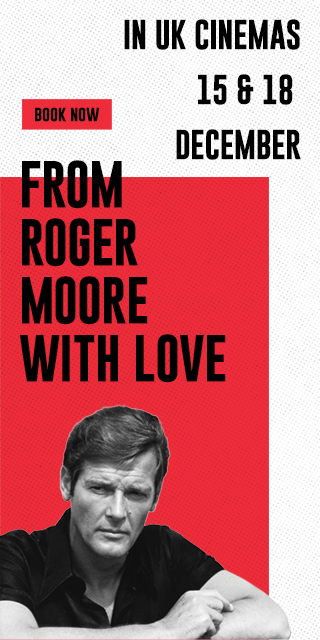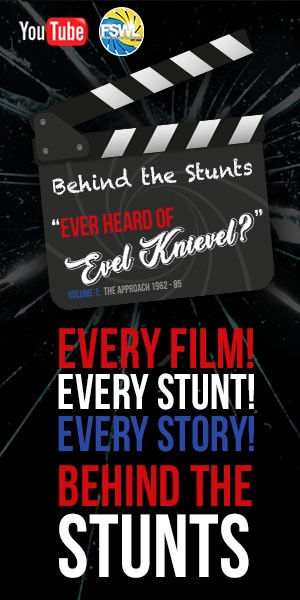Hemsidan senast uppdaterad: 2025-06-10
Hem
Bok- och filmrecensioner
Event
FSWL Merchandise
Intervjuer
James Bond 007 artiklar
James Bond 007 filmerna
James Bond 007 litteratur
James Bond 007 nyheter
James Bond 007 produkter
James Bond 007 samling
James Bond 007 shop
James Bond 007 spel
James Bond fanklubbar
James Bond personligheter
Svenskar i Bond-filmerna
Tävlingar
Manusförfattaren Richard Maibaum (1909-1991)
Av: Anders Frejdh
Publicerad:
2004-09-06
2004-09-06
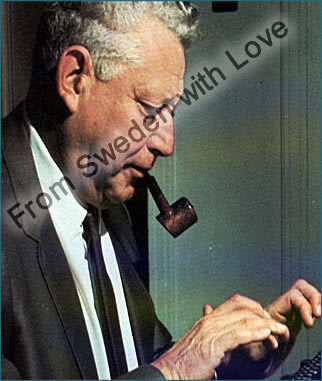
Om det finns någon person som skulle kunna beskriva James Bonds värld skulle det varit den avlidne manusförfattaren, Richard Maibaum. Från och med den första 007 filmen Agent med rätt att döda (1962) spelade han en viktig roll i att forma livet för superspionen. Maibaum arbetade med inte mindre än fjorton av filmerna som antingen ensam författare eller kollaboratör.
Följande opublicerade intervju ägde rum mitt under produktionen av Iskallt uppdrag (1987) som för övrigt var Timothy Daltons debut som 007. Som sådan är det en spännande läsning om en av de främsta kreativa krafterna bakom serien.
Richard Maibaum, James Bond-seriens favoritförfattare, om förändringen av Bond.
Intervjun gjordes av Edward Gross och publicerades första gången den 3 mars 2000.
[Edward Gross:] The Living Daylights (1987) is more of an espionage thriller than some of the most recent Bonds. It's not as light.
[Richard Maibaum:] We did that deliberately. I've been feeling for some time that we've been getting a little too far out, and I like to pull the balloon down every now and then and ground it so that there is a greater sense of reality involved in what's happening. It's easier, I think, for the people to identify with. You can have all the magnificent action in the world, but if you don't care about the people involved with the action, as far as I'm concerned, then something is lost. This was one opportunity where we saw that Bond was not a thoughtless killer, who they pushed a button on so that he would go out and kill somebody. This is one picture where a man wants to be convinced before the man he is assigned to kill is killed. It was kind of a departure for us, as James Bond would be trying to avoid assassinating someone before he has a damn good reason to do so.
[EG:] It's good to see you reaching back to those early thrillers in terms of tone.
[RM:] I think it always helps to have a solid story, and the Fleming short story on which it's based is such a springboard. In it, Bond is assigned to protect a defector coming across, and then sees a girl, who is a member of a girl band, going across the street with a cello case, and as he takes up his post and waits day after day for the time that the defector is going to dash across, he realizes that the assassin, who is attempting to stop him from defecting, is actually the beautiful girl with the cello that he had seen earlier. So he refuses to shoot her, and that, to me, also seemed refreshing, and very Bondian. Bond won't kill a beautiful woman for no reason and all, and also because he likes beautiful girls. So that was a good springboard, and we had to say to ourselves, 'How can we make a two-hour story out of this?' The idea was determining the identity of the defector, what was he supposed to do and so forth. It was not easy to write, but it was a lot of fun to write.
[EG:] It's difficult to come up with these 007 plotlines?
[RM:] Difficult? It certainly is. It's murder. I've said this many times, but the real trick of it is to find the villain's caper. Once you've got that, you're off to the races and the rest is fun.
[EG:] Do you write the stunt scenes by yourself or do you meet with the stunt coordinators to discuss first?
[RM:] There are numerous ways in which they occur. John Glen is very, very inventive as far as stunts go. He's amazing. He used to be a great cutter, and he sees things in his mind visually in terms of film. When he gets an idea for something, he'll discuss it with us and we'll work on it, but actually he is very influential in that department. They happen in various ways. We do a lot of conferring - everybody does - on the Bond pictures. And of course a stunt man himself comes up with some great ideas he'd like to try out. They come to John Glen, discuss it with us and so forth. It's hard to say because the stunts may come from anyone. There is one thing I'd like to bring up. We have a lot of car chases, and so does everybody else, but our car chases always have some novelty in them that excuses them. They're not the same type of chase that you'll find elsewhere.
[EG:] What is the nature of the collaboration between you and Michael G. Wilson?
[RM:] We're equal collaborators. We do a lot of conferring. When we start out, we do a very, very full treatment, sometimes fifty or sixty pages long. We don't do anything like writing three pages worth of treatment on the back of a letter or anything like that. This is, I think, the 21st film I've done with Cubby Broccoli, and he likes to know beforehand what's going to be. We lay it out very carefully. Of course you may deviate from it if you come up with something better, or if something doesn't work, but it is layed out very thoroughly beforehand. We discuss it. Sometimes we sit there and write it together. Sometimes he'll write the first draft or I will write the first draft, and we give it to the other fellow and argue about it. There's an awful lot of arguing that goes on [laughs]. But you know what they say, if collaborators don't argue, then there's one collaborator too many. When you finally settle on something, it's been through the whole process. Cubby has final approval, of course, and then John will sometimes sit in. As I say, it's a true collaboration.
[EG:] I've often read that the Bond films were made by committee.
[RM:] That's cockeyed, too. In the final analysis, the writer, or writers, have to sit down and are responsible for putting all the suggestions together. I don't like the idea of writing by committee, because there isn't a committee. There's input, as there should be on any sensibly set up production. You get as many opinions as possible.
[EG:] The Living Daylights (1987) really seems to be quite topical. Was it conscious effort to make it more accessible to the public?
[RM:] That is an interesting question, because this has happened to us in the past, too. We've started out on something, and suddenly it becomes very, very popular. I can't, offhand, think of the instances or which pictures were involved, but you could be writing something...for instance, we were the first picture to use a laser beam when we did so in Goldfinger (1964). We objected to the way that Fleming had it. He had Bond put on a circular saw which was supposed to cut him in half. We thought that was Pearl White, so we came up with the laser beam. And then later, in Diamonds Are Forever (1971), we found out during research that the first laser beam had been projected not through a ruby, but through a diamond and that's how we got the diamond satellite idea in the sky that projected the beam. Now, what is Star Wars [the defense program] all about? We were twenty years ahead [laughs]. I can't recall all the other instances, but four or five times we were working on something and then it would become highly topical.
[EG:] In interviews, Timothy Dalton said that he would base his portrayal more on the Fleming novels than the earlier films.
[RM:] What I think the films have done is given Bond more humor. He was pretty humorless in the books, and the dimension of humor that we put in there was, I thought, very helpful in the pictures.
[EG:] When you wrote The Living Daylights, were you writing with Pierce Brosnan in mind?
[RM:] Not at all. As a matter of fact, we weren't sure that Roger wasn't going to continue.
[EG:] Oh, there was a possibility of him playing the role again?
[RM:] Yes. You know as well as I do that, financially, Roger's pictures have been the most successful, and, personally, Roger is a most charming man and he took a different route than Connery did, but it seemed to work. The audience liked it very much.
[EG:] I'm just looking forward to the more serious tone.
[RM:] I'm glad about that. What happened is that they kind of veered off course with the pictures, I thought, and then in For Your Eyes Only (1981) we came back to a more serious approach.
[EG:] Whereas Octopussy (1983) and A View to a Kill (1985) had the hype of being a throwback, this one really seems to be one.
[RM:] I agree with you. I think it's something that we used to do in the earlier pictures, and that is when the action would get very wild and so forth, we would deliberately do what we called pulling the balloon down, to give the audience a moment to come back to something more serious. They're willing for you to be serious, because they know that pretty soon you'll be amusing again.
[EG:] How would you say the films have altered over the years?
[RM:] I think they've changed, basically, in terms of the personality of the fellow playing Bond. The Moore pictures have been lighter in tone, as you agreed with, and people seemed to enjoy that very much. As I say, they were very successful.
[EG:] Have you ever developed a theory as to why the films continue?
[RM:] One of the reasons is that they're beautifully produced. Cubby Broccoli is the driving force behind the whole thing. He has good taste; he is attentive...he stays with it. He is completely involved. And the James Bond syndrome, of course, has become worldwide and is sort of in the Sherlock Holmes class now. Hardly a day goes by where I don't see three or four references to James Bond in some way. Newspapers, television and so forth. People talk about it constantly. The whole James Bond syndrome has just become a part of the culture, and I think that has a great deal to do with it. Although the pictures have varied in how they were acceptable to audiences, they continued on a very steady and high level, and the audience knows that they're going to get a good show. They're not going to get short-changed. I think the answer is that they've had a good run because they're good films.
[EG:] But for you, as the primary writer, what is it that keeps you interested?
[RM:] What keeps me going is the desire to do another good film. I enjoy doing it because it's a challenge to come up with new material. You use up so many locales, so many possibilities of plot, so many characters and stuff like that. But we always find some new aspect, and that's the challenge. That's what's exciting.
Läs mer om Richard Maibaums karriär som manusförfattare, kolla in hans profil på IMDB:
www.imdb.com/name/nm0537363/
Taggar:
#nyheter
#till_minne_av
Tweet
